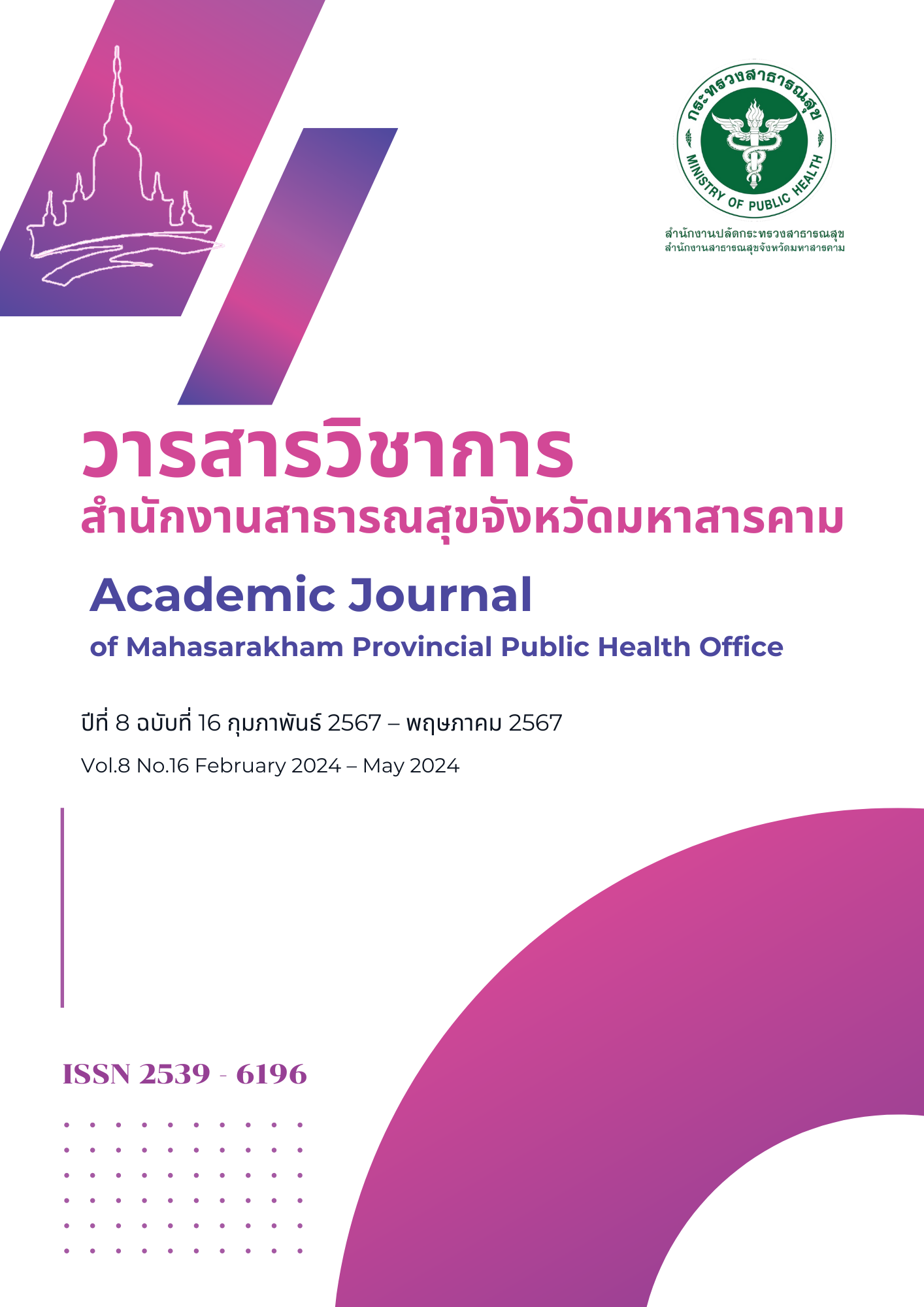การพัฒนาแนวปฏิบัติทางคลินิกการพยาบาลผู้ป่วยที่ได้รับสารน้ำทางหลอดเลือดดำส่วนปลาย ตึกผู้ป่วยใน โรงพยาบาลแกดำ จังหวัดมหาสารคาม
บทคัดย่อ
บทคัดย่อ
การวิจัยเชิงพัฒนานี้มีวัตถุประสงค์เพื่อพัฒนาแนวปฏิบัติทางคลินิกการพยาบาล และประเมินผลของการใช้แนวปฏิบัติทางคลินิกการพยาบาลผู้ป่วยที่ได้รับสารน้ำทางหลอดเลือดดำส่วนปลาย โรงพยาบาลแกดำ จังหวัดมหาสารคาม โดยใช้กรอบแนวคิดการพัฒนาแนวปฏิบัติทางคลินิกของสภาวิจัยแห่งชาติของประเทศออสเตรเลีย (NHMRC) กลุ่มตัวอย่างที่ศึกษาคัดเลือกแบบเจาะจง ประกอบด้วย พยาบาลวิชาชีพผู้ปฏิบัติการให้สารน้ำทางหลอดเลือดดำส่วนปลาย จากตึกผู้ป่วยในที่ดูแล
ผู้ป่วยซึ่งมีประสบการณ์การทำงานไม่น้อยกว่า 1 ปี จำนวน 10 คน เพื่อทดลองใช้และประเมินความเป็นไปได้ของแนวปฏิบัติ จำนวน 20 คน ดำเนินการในช่วงเดือนตุลาคม 2565 – กันยายน 2566 เก็บรวบรวมโดยใช้แบบสอบถามความเป็นไปได้ของแนวปฏิบัติทางคลินิกการพยาบาลผู้ป่วยที่ได้รับสารน้ำทางหลอดเลือดดำ ส่วนปลาย ได้รับการตรวจสอบความตรงตามเนื้อหาจากผู้ทรงคุณวุฒิ 3 ท่าน เพื่อให้ข้อเสนอแนะการแก้ไขและเพิ่มเติมเนื้อหา หลังการปรับปรุงได้นำไปทดลองปฏิบัติ วิเคราะห์ข้อมูลโดยใช้สถิติเชิงพรรณนา
ผลการศึกษา พบว่า แนวปฏิบัติทางคลินิกการพยาบาลที่ผู้ป่วยได้รับสารน้ำทางหลอดเลือดดำส่วนปลาย โรงพยาบาลแกดำ ประกอบด้วย 8 องค์ประกอบ ได้แก่ 1) การเตรียมความพร้อมก่อนให้สารน้ำ 2) การทำความสะอาดมือและ Aseptic technique 3) การเตรียมผิวหนัง 4) การแทงเข็มให้สารน้ำ 5) การดูแลระหว่างให้สารน้ำ 6) การเปลี่ยนเข็มและชุดให้สารน้ำ
7) การเปลี่ยน Dressing และ 8) การดูแลหลังให้สารน้ำ ผลของพยาบาลวิชาชีพผู้ใช้แทนวปฏิบัติการให้สารน้ำทางหลอดเลือดดำส่วนใหญ่มีอายุระหว่าง 25 - 39 ปี ร้อยละ 80 ปฏิบัติงานมากกว่า 5 ปีขึ้นไป ร้อยละ 70 ได้รับความรู้เรื่องการให้สารน้ำทางหลอดเลือดดำส่วนปลาย ร้อยละ 100 การประเมินความเป็นนไปได้ของแนวปฏิบัติ พบว่า ความชัดเจนของข้อเสนอแนะในแนวปฏิบัติ และความเป็นไปได้ทางปฏิบัติที่จะนำไปใช้ในหน่วยงานความคิดเห็นอยู่ในระดับมาก ร้อยละ 95 ความคิดเห็นเกี่ยวกับการใช้แนวปฏิบัติมีความสะดวกความเหมาะสมต่อการนำไปใช้ในหน่วยงาน ความประหยัดและลดต้นทุน แนวปฏิบัติสามารถแก้ปัญหาและเกิดผลดีต่อผู้รับบริการอยู่ในระดับมาก ร้อยละ 100 เท่ากัน ผลการศึกษานี้ชี้ให้เห็นว่าแนวปฏิบัติทางคลินิกการพยาบาลผู้ป่วยที่ได้รับสารน้ำทางหลอดเลือดดำส่วนปลายที่พัฒนาขึ้นสามารถนำไปใช้ในการปฏิบัติงานได้จริง
คำสำคัญ : การพัฒนา, แนวปฏิบัติทางคลินิกการพยาบาลผู้ป่วยที่ได้รับสารน้ำทางหลอดเลือดดำส่วนปลาย


